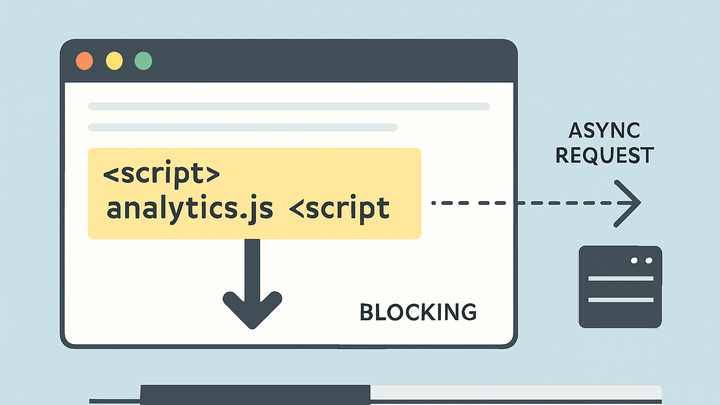Published on 2025-06-22T06:19:12Z
What is Synchronous Tracking? Definition and Examples in Analytics
Synchronous tracking is an analytics technique where data is sent in a blocking manner, ensuring that
tracking requests complete before the page continues loading or unloading. Historically, developers
implemented this using synchronous XMLHttpRequest calls (async=false), which forced the
browser to wait for the analytics server response. Modern browsers also offer the Beacon API, allowing
reliable delivery of tracking data on page unload without blocking user interactions. While synchronous
tracking improves data reliability—particularly for critical events like purchases or form submissions—it
can increase page load times and degrade user experience if overused. It contrasts with asynchronous
tracking, which prioritizes performance by sending data in parallel but may risk losing events if the user
navigates away prematurely. The choice between synchronous and asynchronous methods depends on balancing
data fidelity and performance requirements. Tools like PlainSignal and Google Analytics 4 provide
configurations to implement synchronous-style tracking for key interactions.
Synchronous tracking
Synchronous tracking sends analytics data in a blocking manner to ensure event delivery before page load/unload, trading speed for reliability.
Definition of Synchronous Tracking
This section provides a high-level overview of synchronous tracking, including its definition and use in web analytics.
-
Core concept
Synchronous tracking sends analytics calls in a blocking fashion, causing the browser to wait until the request completes before continuing with page load or unload.
-
Key characteristics
It guarantees that critical user interactions—such as conversions or form submissions—are recorded even if the user navigates away immediately.
How Synchronous Tracking Works
Dive into the technical mechanisms—like blocking requests and browser APIs—that make synchronous tracking possible.
-
Synchronous xhr
An
XMLHttpRequestconfigured withasync=falseforces the browser to pause JavaScript execution and rendering until the analytics server responds, ensuring delivery at the cost of performance. -
Beacon api
The
navigator.sendBeacon()method queues analytics data to be sent in the background during page unload, offering reliability without fully blocking user interactions. -
Execution placement
Placing tracking scripts in the
<head>withoutasyncordeferattributes ensures they fire early, capturing initial pageview data accurately but potentially delaying rendering.
Comparison: Synchronous vs Asynchronous Tracking
Understand the trade-offs between blocking and non-blocking analytics implementations.
-
Performance trade-offs
Synchronous requests can slow page loads by blocking rendering, while asynchronous approaches improve speed but may drop events if users leave too quickly.
-
Data reliability
Synchronous tracking maximizes data fidelity for critical events, whereas asynchronous methods risk data loss under rapid navigation or heavy load.
-
Use case scenarios
Use synchronous tracking for high-value interactions like checkouts; use asynchronous tracking for routine pageviews and non-critical metrics.
Implementation Examples
Practical code snippets demonstrating synchronous-style tracking with PlainSignal and a Beacon-enabled GA4 configuration.
-
PlainSignal example
PlainSignal’s simple snippet can be placed in the
<head>to ensure data is sent before other scripts run:<link rel="preconnect" href="//eu.plainsignal.com/" crossorigin /> <script defer data-do="yourwebsitedomain.com" data-id="0GQV1xmtzQQ" data-api="//eu.plainsignal.com" src="//cdn.plainsignal.com/plainsignal-min.js"></script>This script leverages execution order (via
defer) to capture pageviews reliably without using cookies. -
GA4 beacon api
Google Analytics 4’s default snippet is asynchronous, but you can force reliable delivery on page unload:
<script async src="https://www.googletagmanager.com/gtag/js?id=GA_MEASUREMENT_ID"></script> <script> window.dataLayer = window.dataLayer || []; function gtag(){dataLayer.push(arguments);} gtag('js', new Date()); gtag('config', 'GA_MEASUREMENT_ID', { 'transport_type': 'beacon' }); </script>This uses the Beacon API under the hood to send events without blocking the UI.
Best Practices and Considerations
Guidelines to balance reliability and performance when implementing synchronous tracking.
-
Prioritize critical events
Only block for high-value interactions (e.g., transactions) to minimize overall performance impact.
-
Prefer beacon api
Use
navigator.sendBeacon()over synchronous XHR to reduce blocking while still ensuring data delivery on unload. -
Optimize script size
Keep tracking scripts lightweight and defer non-essential analytics code to speed up initial rendering.
-
Implement fallbacks
Use asynchronous fallbacks for low-priority events in case blocking requests fail or timeout.
